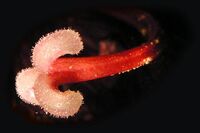
Amaryllis style and stigmas
Gynoecium (from Ancient Greek, gyne, meaning woman, and oikos, meaning house) is most commonly used as a collective term for all carpels in a flower. A carpel is the ovule and seed producing reproductive organ in flowering plants. Carpels are derived from ovule-bearing leaves which evolved to form a closed structure containing the ovules. They did this by folding and fusing at their edges to form a chamber in which the ovules develop. In many flowers, several to many carpels are fused into a structure that resembles a single carpel. The term gynoecium is useful because it refers to the ovule producing structure in a flower, whether it is a single carpel, multiple unfused carpels or multiple fused carpels. In a typical flower, the gynoecium is the innermost whorl of structures and is surrounded by the androecium (stamens) and then by the perianth (all the petals and sepals). In imperfect or incomplete flowers the androecium and perianth, respectively, may be absent. The gynoecium is often referred to as female because it gives rise to female (egg-producing) gametophytes, however, strictly speaking sporophytes do not have sex, only gametophytes do. Flowers that bear a gynoecium but no androecium are called carpellate. Flowers lacking a gynoecium are called staminate.
A gynoecium may consist of a single carpel, multiple distinct (unfused) carpels or multiple connate (fused) carpels. Each carpel typically contains one or more ovules. During pollination, pollen is deposited on the gynoecium (typically on a stigma). Successful germination of pollen and growth of pollen tubes results in fertilization of ova. There is typically one ovum in each ovule. After fertilization, ovules develop into seeds, and the gynoecium forms the pericarp of the associated fruit. Gynoecium development and arrangement is important in systematic research and identification of angiosperms, but can be the most challenging of the floral parts to interpret.
In addition to this use of the term gynoecium in flowering plants, in reference to mosses, liverworts and hornworts, gynoecium refers to a cluster of archegonia and any associated modified leaves or stems present on a gametophyte shoot.

Centre of a Ranunculus repens (Creeping Buttercup) showing multiple unfused carpels surrounded by longer stamens.
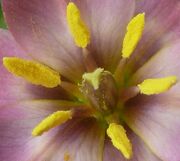
Centre of a Tulipa aucheriana (Tulip) showing multiple connate carpels (a compound pistil) surrounded by stamens.
Carpel morphology[]
A monocarpous (single carpel) gynoecium in context. The gynoecium (whether composed of a single carpel or multiple fused carpels) is typically made up of an ovary, style, and stigma in the center of the depicted flower.
Carpels are the building blocks of the gynoecium. Gynoecia (whether composed of a single carpel or multiple fused carpels) typically consist of:
- An enlarged basal portion called the ovary (from Latin ovum meaning egg), which contains placentas bearing one or more ovules (integumented megasporangia). The chamber in which the ovules develop is called a locule (or sometimes cell).
- The style (from Ancient Greek stülos meaning a pillar), a pillar-like stalk through which pollen tubes grow to reach the ovary.
- The stigma (from Ancient Greek, stigma meaning mark, or puncture), usually found at the tip of the style, the portion of the carpel that receives pollen (male gametophytes). It is commonly sticky or feathery to capture pollen.
Carpels begin as small primordia on a floral apical meristem, forming later than, and closer to the (floral) apex than sepal, petal and stamen primordia. Morphological and molecular studies of carpel ontogeny reveal that carpels are most likely homologous to leaves. In some basal angiosperm lineages, for example in Degeneria, native to Fiji, carpels begin as a shallow cup and eventually form a folded, leaf-like structure, sealed at its margins by interlocking hairs. No stigma or style exists, but a broad stigmatic crest allows pollen tubes access to two rows of ovules enclosed in the carpel. Carpels, like leaves, generally bear three vascular traces.
Types of gynoecia[]
If a gynoecium has a single carpel, it is called monocarpous. If a gynoecium has multiple, distinct (free, unfused) carpels, it is apocarpous. If a gynoecium has multiple carpels fused into a single structure, it is syncarpous. A syncarpous gynoecium can sometimes appear very much like a monocarpous gynoecium.
The degree of connation (fusion) in a syncarpous gynoecium can vary. The carpels may be fused only at their bases, but retain separate styles and stigmas. The carpels may be fused entirely, except for retaining separate stigmas. Sometimes (e.g., Apocynaceae) carpels are fused by their styles or stigmas but possess distinct ovaries. In a syncarpous gynoecium, the fused ovaries of the constituent carpels may be referred to collectively as a single compound ovary. It can be a challenge to determine how many carpels fused to form a syncarpous gynoecium. If the styles and stigmas are distinct, they can usually be counted to determine the number of carpels. Within the compound ovary, the carpels may have distinct locules divided by walls called septa. If a syncarpous gynoecium has a single style and stigma and a single locule in the ovary, it may be necessary to examine the attached of the ovules. Each carpel will usually have a distinct line of placentation where the ovules are attached.
Gynoecium position[]
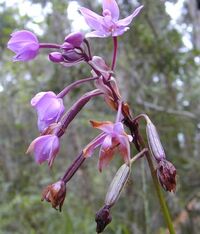
Flowers and fruit (capsules) of the ground orchid, Spathoglottis plicata, illustrating an inferior ovary.
Basal angiosperm groups tend to have carpels arranged spirally around a conical or dome-shaped receptacle. In later lineages, carpels tend to be in whorls.
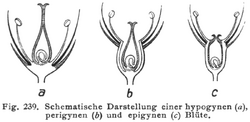
Illustration showing longitudinal sections through hypogynous (a), perigynous (b), and epigynous (c) flowers
The relationship of the other flower parts to the gynoecium can be an important systematic and taxonomic character. In some flowers, the stamens, petals, and sepals are fused into a "floral tube" or hypanthium.
If the hypanthium is absent, the flower is hypogynous, and the stamens, petals, and sepals are all attached to the receptacle below the gynoecium. Hypogynous flowers are often referred to as having a superior ovary. This is the typical arrangement in most flowers.
If the hypanthium is present and fused to the gynoecium up to the base of the style(s), the flower is epigynous. In an epigynous flower, the stamens, petals, and sepals are attached to the hypanthium at the top of the ovary or, occasionally, the hypanthium may extend beyond the top of the ovary. Epigynous flowers are often referred to as having an inferior ovary. Plant families with epigynous flowers include orchids, asters, and evening primroses.
Between these two extremes are perigynous flowers, in which a hypanthium is present, but is either free from the gynoecium (in which case it may appear to be a cup or tube surrounding the gynoecium) or fused partly to the gynoecium (with the stamens, petals, and sepals attached to the hypanthium part of the way up the ovary). Perigynous flowers are often referred to as having a half-inferior ovary (or, sometimes, partially inferior or half-superior). This arrangement is particularly frequent in the rose family and saxifrages.
Occasionally, the gynoecium is born on a stalk, called the gynophore, as in Isomeris arborea.
Placentation[]
Within the ovary, each ovule is born by a placenta. These placentas often occur in distinct lines called lines of placentation. In monocarpous or apocarpous gynoecia, there is typically a single line of placentation in each ovary. In syncarpous gynoecia, the lines of placentation can be regularly spaced along the wall of the ovary (parietal placentation), or near the center of the ovary. In the latter case, separate terms are used depending on whether or not the ovary is divided into separate locules. If the ovary is divided, with the ovules born on a line of placentation at the inner angle of each locule, this is axile placentation. An ovary with free central placentation, on the other hand, consists of a single compartment without septae and the ovules are attached to a central column. In some cases a single ovule is attached to the bottom or top of the locule (basal or apical placentation, respectively).
The ovule[]
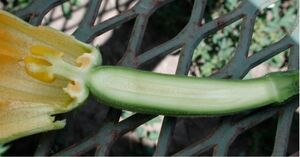
Longitudinal section of carpellate flower of squash showing ovary, ovules, pistil, and petals
The ovule (from Latin ovulum meaning small egg) is a complex structure, born inside ovaries of carpels in angiosperms. The ovule initially consists of a stalked, integumented megasporangium. Typically one cell in the megasporangium undergoes meiosis resulting in one to four megaspores. These develop into reduced megagametophytes (often called embryo sacs) within the ovule. Before fertilization, the ovule consists of one or two layers of integuments surrounding the remains of the megasporangium, called the nucellus and an embryo sac, with a small number of cells and nuclei, including one egg cell and two polar nuclei (which will form, together with a sperm cell, the primary endosperm nucleus). The gap in the integuments through which the pollen tube enters to deliver sperm to the egg is called the micropyle. The stalk attaching the ovule to the placenta is called the funiculus. Ovules are typically positioned so that the micropyle is facing the point of funiculus attachment, but other positions are found in a variety of plant groups.
The stigma and style[]
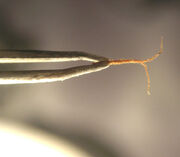
Stigmas and style of Cannabis sativa held in a pair of forceps
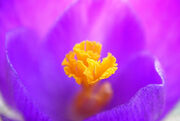
Stigma of a Crocus flower.
The style and stigma of the flower are involved in most types of self incompatibility reactions. Self incompatibility, if present, prevents fertilization by pollen from the same plant or from genetically similar plants, and ensures outcrossing.
Stigmas can vary from long and slender to globe shaped to feathery. The stigma is the receptive tip of the carpel, which receives pollen at pollination and on which the pollen grain germinates. The stigma is adapted to catch and trap pollen, either by combining pollen of visiting insects or by various hairs, flaps, or sculpturings. Stigmas must distinguish and reject the pollen of other species, and in some cases are responsible for self incompatibility.
The style of a pistil is the tube-like portion between the stigma and the ovary. It can be either long or short. In some cases the style is responsible for self incompatibility, causing pollen tubes to fail.
Pistils[]
The word pistil (from Latin pistillum meaning pestle) is also sometimes used to describe each discrete unit of the gynoecium. A pistil can consist of either a single carpel (in a monocarpous or apocarpous gynoecium), in which case it is called a simple pistil, or of several fused carpels (in a syncarpous gynoecium), in which case it is called a compound pistil.
| Gynoecium composition | Carpel terminology | Pistil terminology | Examples |
|---|---|---|---|
| Single carpel | Monocarpous (unicarpellate) gynoecium | A pistil (simple) | Avocado (Persea sp.), most legumes (Fabaceae) |
| Multiple distinct (unfused) carpels | Apocarpous (choricarpous) gynoecium | Pistils (simple) | Strawberry (Fragaria sp.), buttercup (Ranunculus sp.) |
| Multiple connate
(fused) carpels |
Syncarpous gynoecium | A pistil (compound) | Tulip (Tulipa sp.), most flowers |